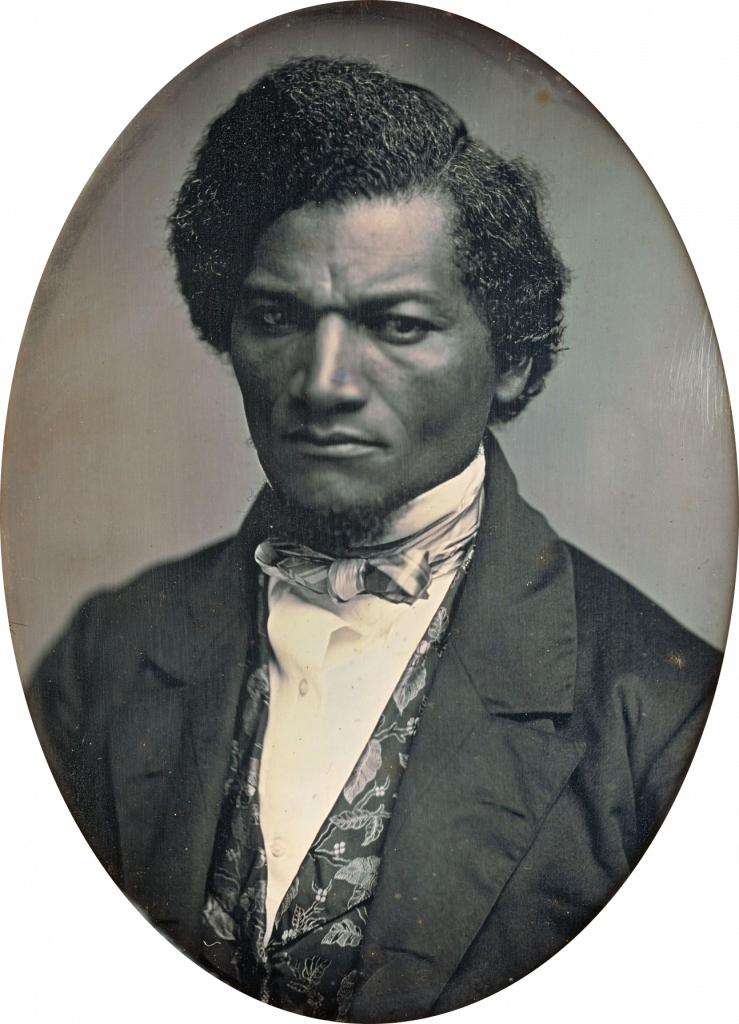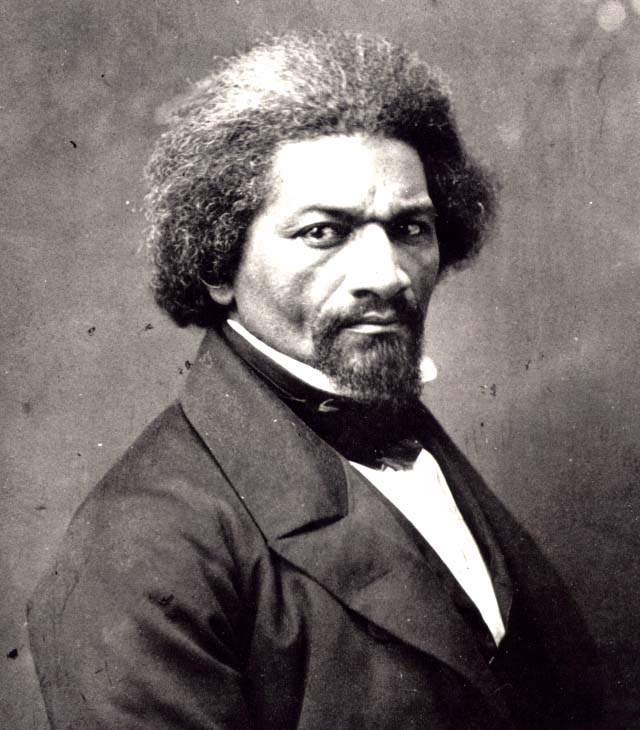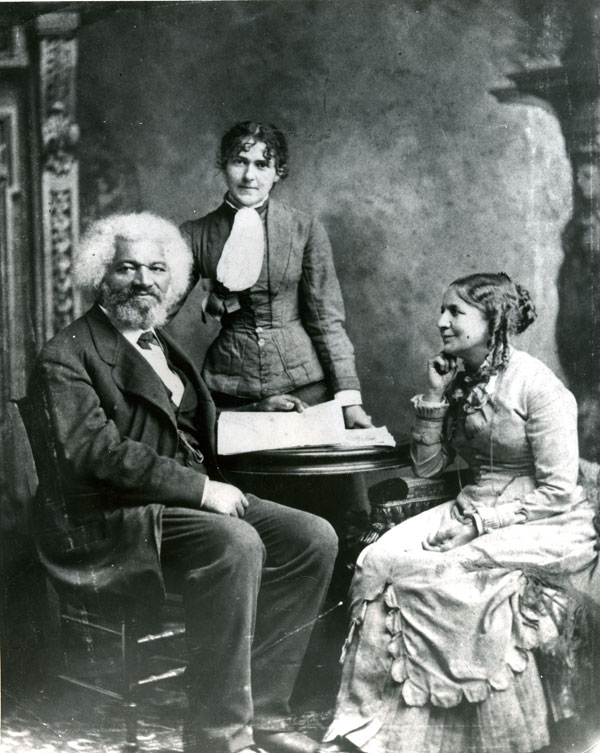Frederick Douglass is a well known African-American who escaped from slavery and went on to become a prominent abolitionist, social reformer, writer, orator, and statesman from the Civil War period. He became famous throughout America for his many speeches that contacted the Southerners beliefs that slaves were not intelligent enough to function on their own. In later years, Douglass was also a firm supporter of the women’s suffrage movement. He even ran as the first ever African American vice president for Victoria Woodhull, who did not end up making it very far in the election.
Around February of 1818, Frederick Augustus Washington Bailey was born to Harriet Bailey, a slave, in Maryland. His father is thought to be Aaron Anthony. Douglass was of mixed race, having an African American mother who was also believed to have native American in her while his father was European. When he was very young, Douglass was separated from his mother and he lived with Betty Bailey, his grandmother. At seven, Douglass was then separated from his grandmother and was taken to Wye House plantation with Aaron Anthony, his possible father, as the overseer. Around ten years old, Harriet Bailey died and Anthony followed not long after, so Douglass was given to Lucretia Auld. Lucretia had Douglass work for her husband’s brother, Hugh Auld, out in Baltimore.
Douglass began to learn the alphabet when he was around twelve years old by Sophia Auld, Hugh’s wife. He described Sophia as a very kind person who believed that humans should be treated the same. However, Hugh Auld disapproved of his wife’s action because he feared having literate slaves would encourage them to escape. One day, Sophia even had to take a newspaper away from Douglass after developing her husband’s beliefs. Despite orders not to from his masters, Douglass secretly taught himself to read and write after observing young white boys learning how in the area. He began to question slavery as he continued reading everything he could get his hands on. Later in life, he would credit his early views on freedom to the anthology The Columbian Orator.
Soon, William Freeland had Douglass come work for him after being hired out. While there, he began teaching other slaves at a weekly Sunday school how to read the New Testament. Word spread and so many slaves became interested that there were over forty attendants each week. It took six months for anyone to realize what was going on at the plantation. Freeland did not care much, but other slave owners were furious. They burst in on them one Sunday with clubs and stones to stop the slaves from meeting there anymore. Thomas Auld, Hugh’s brother, took Douglass back in 1833 and sent him to work for Edward Covey. Covey was a fairly poor farmer and was known for his abuse towards slaves and would constantly whip Douglass, causing him to be nearly psychologically broken. He began fighting back though and was never beat again by Covey after winning a physical confrontation.
Twice Douglass failed to escape, once when he was hired out by William Freeland and another time with Covey in 1836. The following year, Douglass fell in love with a free black woman named Anna Murray. Murray was five years older and living in Baltimore at the time. Douglass’s desire to escape slavery was fueled by her. She gave him sailor’s clothing from her work as a laundress and some of her savings to help him escape. Douglass successfully escaped slavery on September 3, 1838 by boarding a train that stopped just outside of Philadelphia. From there, he traveled through Delaware with the clothes provided to him from Murray. In less than twenty-four hours, he made it from Maryland to New York City where he stayed with abolitionist David Ruggles. Murray then traveled to meet him in New York. With her, she brought what was needed so they could establish a household. On September 15, 1838, the couple got married and changed their name to Johnson to divert attention away from themselves.
Douglass and Murray, now the Johnsons, settled into a home in New Bedford, Massachusetts. When they met Nathan and Mary Johnson, they decided to adopt the married name Douglass instead.They had gotten the name from Nathan Johnson who got it out of The Lady of the Lake. At first, the Douglasses joined a white Methodist church but found it was heavily segregated and joined the African Methodist Episcopal Zion Church instead. In 1839, he became a licensed preacher which helped him with his skills as an orator. He delivered a speech the next year at an Underground Railroad “station” in Elmira, New York. Douglass began attending many abolitionist meetings in New Bedford along with several other organizations. He was a huge fan of William Lloyd Garrison as well and went to one of his speeches in 1841. Douglass unexpectedly spoke at another meeting not long after. Many people began encouraging him to become an anti-slavery lecturer. At about twenty-three years old, he gave a speech about his life as a slave at the Massachusetts Anti-Slavery Society’s annual convention in Nantucket. Douglass continued making speeches about slavery. Once, he was even beaten by an angry mob in 1843 in Pendleton, Indiana. It left him with a broken arm that never healed properly and would bother him for the rest of his life.
Published in 1845, Douglass became well known for his autobiography Narrative of the Life of Frederick Douglass, an American Slave. People were skeptical that a black man could even publish a piece as well-written eloquent because of their beliefs African Americans weren’t intelligent enough to do such a thing. Immediately, it was a bestseller with great reviews. After three years of it being published the book had already been printed nine times and there were over 11,000 copies in the United States. Not only was it published in the U.S., but it was also translated into French and dutch so it could be sold in Europe. With the money made from his autobiography, Douglass was able to gain freedom legally. He also published two more: My Bondage and my Freedom in 1855 and Life and Times of Frederick Douglass in 1881. His first autobiography though was the most popular.
After encouragement from his friends that Douglass’s growing popularity would attract the attention of Hugh Auld, Douglass sailed for Liverpool on August 16, 1845. In Ireland, he was surprised to find that he was treated equally instead of in the U.S. where racial discrimination and segregation was a major problem. Not long after his arrival, he befriended Daniel O’Connell, an Irish nationalist, who would continue to inspire him throughout his life. For two years, he traveled through Ireland and Britain, giving many lectures and speeches in various churches and chapels. So many people came to see him speak that it was not uncommon for the churches it became so overcrowded Douglass described it as hard to breathe. In England, he wrote that he was treated as a man and not by the color of his skin. Douglass met so many abolitionists and supporters that encouraged him to stay in England though he knew he had to return home to be with his wife and help out others still enslaved. During the spring of 1847, he returned to Massachusetts.
Upon returning home, Douglass began to publish his own newspaper out of the basement of the Memorial AME Zion Church located in Rochester, New York called The North Star. Rosetta, his eldest child, and Charles Remond Douglass, his fourth child and youngest son, helped him out with the newspaper later on. “Right is of no Sex – Truth is of no Color – God is the Father of us all, and we are all brethren,” was the motto of The North Star. Supporters in England gave him five hundred pounds to use as he wished, which he used for the newspapers. This also caused him to drift away from Garrison, who he was once good friends with because The North Star was seen as a competitor to Garrison’s National Anti-Slavery Standard.In 1851, The North Star merged with Liberty Party Paper written by Gerrit Smith to make Frederick Douglass’ Paper. This newspaper would be in print until 1860. Douglass once even sent a letter to Thomas Auld, his former owner, in September 1848 asking him how he would feel if his daughter was split up from their family and taken into slavery.
The Seneca Falls Convention in 1848 was the first women’s rights convention. Douglass was the only African American in attendance. Elizabeth Cady Stanton, an accomplish women’s rights activist hosted the convention and had Douglass speak in favor of it. At the convention, he said that as a black man he could never accept the right to vote unless women could too. He believed that if it was more socially acceptable for women to be involved in politics, the world would be a better place.
In this denial of the right to participate in government, not merely the degradation of woman and the perpetuation of a great injustice happens, but the maiming and repudiation of one-half of the moral and intellectual power of the government of the world.
However, Stanton and Douglass disagreed later on when the 15th Amendment was passed after the Civil War. Douglass supported the amendment, which gave black men the right to vote, but Stanton opposed it. He said that after black men were given the right to vote, it would not be long before all women were too, while Stanton thought it would take even longer. Stanton said that women and black men should join together to fight for the vote, but Douglass realized that would be hard because not enough men supported the women’s suffrage movement. Douglass made sure that everyone knew that he was never against women’s rights to vote though, and he still supported the cause after the 15th Amendment.
On July 5, 1852 Douglass gave what some people called the greatest anti-slavery oration ever to the Rochester Anti-Slavery Sewing Society. He also began advocating for desegregating schools because he believed education would be crucial if African Americans wanted to improve their lifestyles. During the 1850s he made tours and observed schools in New York were not giving African American children the same education as white children. Douglass even said that improving education and schools for black children was even more crucial than political issues surrounding blacks. Following John Brown’s raid at Harpers Ferry on the federal armory, Douglass fled to Canada in fear of being arrested for conspiring with Brown, though he disapproved of his plan early on. His youngest child and daughter, Annie, died at ten years old while Douglass was in England in March of 1860. The next month, Douglass returned home but made sure to travel through Canada so he could avoid detection.
Around the time of the Civil War, Douglass had become one of the most famous and well-known black men in the U.S. People knew him for his eloquent orations on issues such as slavery and black rights along with women’s rights that gathered large crowds. He was also very famous throughout England and Ireland after taking frequent trips there. When the Civil War started though, Douglass, along with many other abolitionists, believed that black men should have the right to fight because the main purpose was to ultimately end slavery. He made sure people knew his views by publishing them in many newspapers and making several speeches.
Two years after the war started in 1863, he met with President Abraham Lincoln to discuss how black soldiers were being treated in comparison to white soldiers. Douglass was a huge supporter of John C. Frémont during the Election of 1864 and was disappointed that Lincoln had made no point endorsing black suffrage. He said that because African American men were allowed to fight in the war, there was no reason they shouldn’t vote either. When free Northern states were no longer required to return escaped slaves back to the South, Douglass began publicly fighting for equality among his people. He was a recruiter for the 54th Massachusetts Infantry Regiment during the war as well, and had his son Charles Douglass join the regiment. Charles was ill for most of his time in the war though, and hardly fought. His son Lewis Douglass fought at the Battle of Fort Wagner and Frederick Douglass Jr, one of his sons, was also a recruiter.
Soon after the war, Douglass became a citizen and was able to vote when the 13th, 14th, and 15th Amendments were passed. Over ten years later, he gave the keynote speech on April 14, 1876 when the Emancipation Memorial was unveiled in Lincoln Park, Washington, D.C. Douglass both criticized and praised Lincoln. He was given a standing ovation afterwards from the crowd, too. In appreciation, Lincoln’s favorite walking stick was gifted to Douglass from Mary Lincoln.
Even after the war though, Douglass did not end his work in gaining rights for other African-Americans, and women as well. His work gained him popularity and recognition, which led to receiving many different political appointments once African-Americans were permitted to hold those positions. For some time he was president for the Freedman’s Savings Bank during the Reconstruction Era. He was also the chargé d’affaires for the Dominican republic. However, he resigned from that position quickly due to disagreements with the government policy in the U.S. at that time.
In 1868, Douglass was a firm supporter of Ulysses S. Grant for president because of Democrats from former Confederate states had regained political power. Two years later, he started the New National Era, which would be his last newspaper. The purpose of this one was to try to stop discrimination of blacks and keep equality. When Grant became president, he sent Douglass a commission sponsored by Congress to the West Indies. There, he wanted Douglass to investigate if Santo Domingo’s annexation would be good in terms of the U.S. Grant’s idea was to give Santo Domingo to the blacks as people in the South continued to discriminate against them, physically and verbally. Though Congress was not, Douglass was in favor of annexation. He even criticized the opposed senator, Charles Sumner, by saying that he could be one of the worst enemies for blacks.
Douglass became the first black man to ever be nominated for Vice President in 1872. Victoria Woodhull, the first women to ever run, chose him as her running mate. The two were both very supportive of women’s rights and women’s suffrage. However, Douglass did not even know of his nomination, and did nothing to campaign. Woodhull did not end up getting very far in the election though. That same year, an entire issue of The North Star was lost when his home in Rochester burned down of suspected arson. After that, Douglass moved to Washington, D.C. with his family. He did not stop making speeches though, and continued to do so throughout the Reconstruction Era. Twenty-five years after the war he gave a very notable speech that countered all the racism that followed. He traveled around the country to speak at colleges and schools as well.
The New Era failed shortly after it began printing while the country was in an economic crisis. Douglass became a United States Marshal for the District of Columbia under the presidency of Rutherford B. Hayes. This helped his family financially though, especially since he had lost one of his newspapers. He even met with Thomas Auld, his former master, in 1877 when Auld was dying. Amanda Auld Sears, Thomas’s daughter, had arranged the meeting and had even cheered Douglass on during one of his speeches. Douglass also bought a new home in 1877 in Washington, D.C. above the Anacostia River. He named it Cedar Hill with help from Anna. Today, the house can now be visited at the Frederick Douglass National Historic Site.
Anna Murray Douglass, his wife, died in 1882. The couple had five children together: Rosetta, Lewis Henry, Frederick Douglass, Jr., Charles Redmond, and the deceased Annie who had lived to ten years old. Douglass had relationships with other women such as Julia Griffiths and Ottilie Assing, yet Anna remained very supportive and faithful to him. In 1884, Douglass married Helen Pitts, a white woman who was also in favor of women’s equality. Many people criticized the marriage because Douglass was black and Pitts white. They were also nearly twenty years apart in age. The two were very in love, and Douglass countered all the criticism by saying that his father was white and his mother black, and he had married both a black and a white women.
After the death of his wife, Douglass was at first very devastated and mourned her greatly. He began speaking again though after he married Helen Pitts. Douglass kept traveling through America, and also abroad to Europe. With Helen, he traveled in 1886-87 to England, Egypt, Ireland, France, Italy, and Greece. While at the 1888 Republican National Convention, he received a presidential vote and became the first African American to ever do so.
Douglass spoke out against the Exodusters and people in support of the Back-to-Africa movement. He urged other African Americans to stick out and not follow these movements in 1892 at a conference in Indianapolis. Under the presidency of Benjamin Harrison in 1889, Douglass was appointed United States’s Minister and consul-general to Haiti along with the Chargé d’affaires for Santo Domingo. Two years later, he resigned.
Not long before his death, Douglass received a standing ovation after a powerful speech made at a meeting of the National Council of Women. Frederick Douglass died just after getting home on February 20, 1895 due to a heart attack or stroke at seventy-seven years old.





